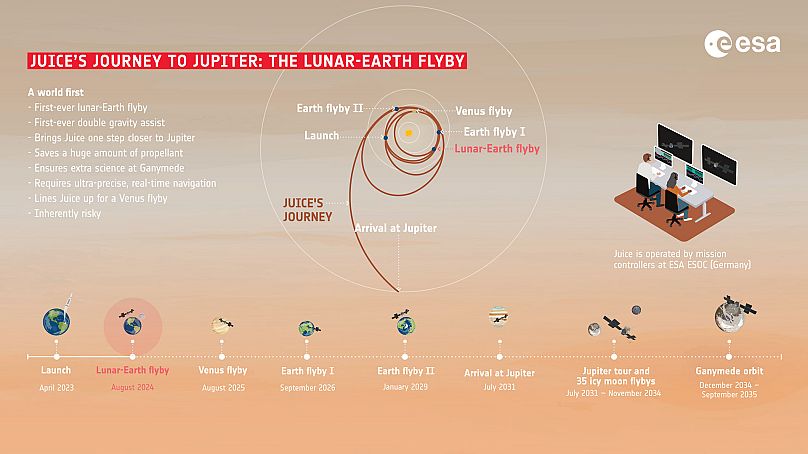The agency says it is attempting a "double-world first" – the first-ever lunar-Earth flyby and the first-ever double gravity assist manoeuvre.
A European spacecraft is set to fly by the Moon and the Earth next week, using gravity to navigate its course on the way to its destination of Jupiter.
The European Space Agency (ESA) says it’s a "double-world first" – the first-ever lunar-Earth flyby and the first-ever double gravity assist manoeuvre.
Gravity assist is a planetary exploration technique that uses gravity to correct its course towards Earth and then Venus on its journey to Jupiter.
It can be used when there isn’t enough propellant or a powerful enough rocket to go to a destination directly.
"You need a gravitational assist - or pull - from the planets to help you get enough energy and be able to fly up to Jupiter," said Nicolas Altobelli, ESA's Jupiter Icy Moons Explorer (JUICE) Mission Manager.
ESA says the lunar-Earth flyby is a "daring feat" as even a small mistake could take the spacecraft off course.
JUICE will fly extremely close to both the Moon and Earth and between August 17 and 22, ESA’s ground stations around the world will be in continuous contact with the spacecraft.
"It’s like passing through a very narrow corridor, very, very quickly: pushing the accelerator to the maximum when the margin at the side of the road is just millimetres," Ignacio Tanco, JUICE’s Spacecraft Operations Manager, said in a statement.
According to ESA, the spacecraft’s path has already been adjusted by the ESA’s flight control team.
During the lunar-Earth flyby, our planet will bend Juice’s trajectory through space, "braking" it and redirecting it on course for another flyby of Venus in August 2025, ESA said.
It will then return towards Earth for two more flybys in 2026 and 2029 to gain enough force to head to Jupiter by 2031.
ESA says this route has been carefully planned by JUICE’s dedicated mission analysis team over the past 20 years.
JUICE mission - a long journey
Juice was launched in April 2023 to investigate Jupiter’s icy moons, including a water ocean on Ganymede.
In 2031, the spacecraft is expected to finally arrive at Jupiter, a planet on average 800 million km away from Earth and almost 600 million km away at its closest point in orbit.
If JUICE were to be flying directly to Jupiter, without an enormous rocket, it would have required an impossible 60,000 kg of onboard propellant.
ESA says it will activate the spacecraft’s ten science instruments during the first flyby as it will be a good test environment for teams to collect and analyse data.
According to ESA, JUICE's Radar for Icy Moon Exploration (RIME) instrument is being disturbed by some electronic noise within the spacecraft and needs to be checked.
During its nearest pass by the Moon, RIME will have eight minutes to conduct observations, with all other instruments either powered down or operating in quiet mode.
Using the data gathered during this time, the RIME team will develop an algorithm to address the noise issue.
For more on this story, watch the video in the media player above.












